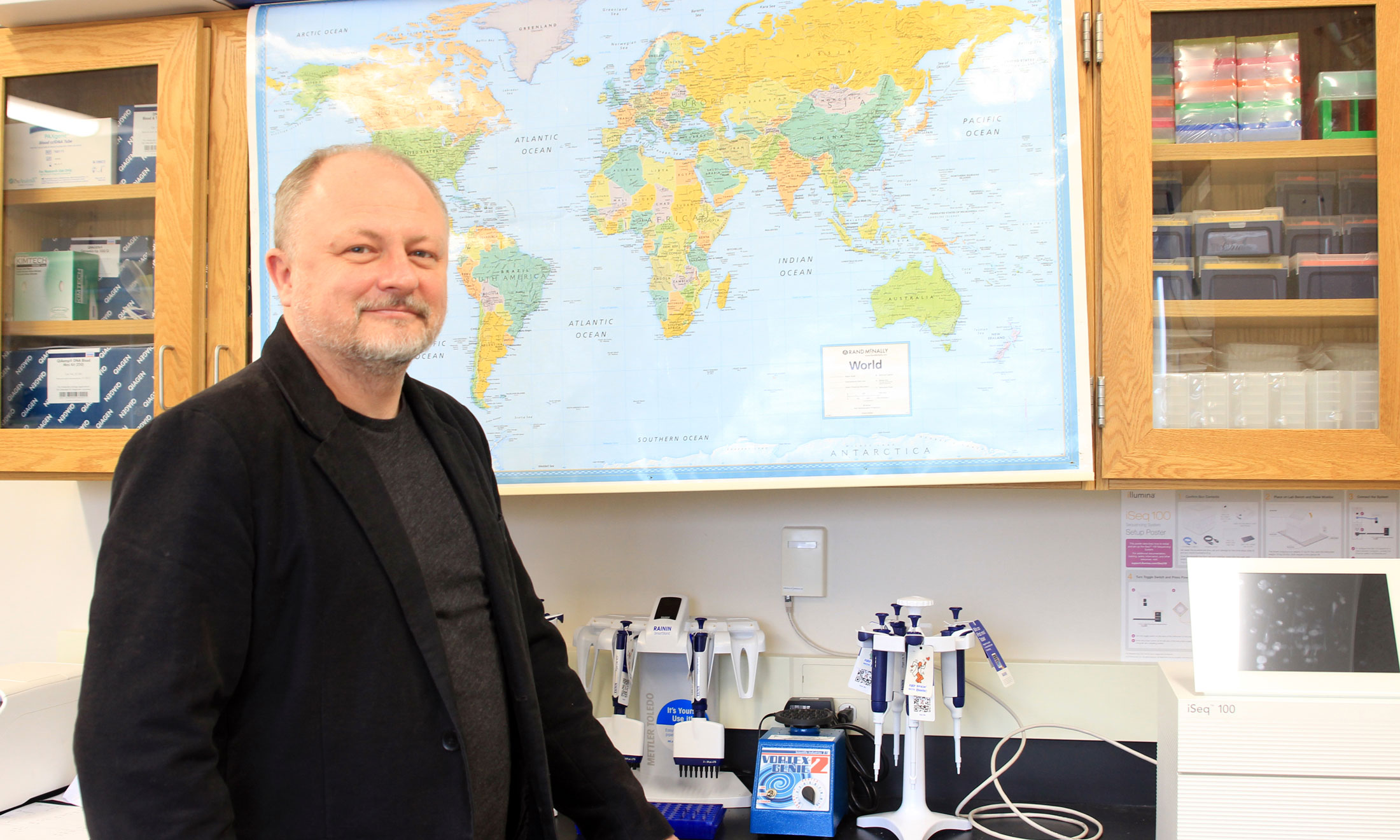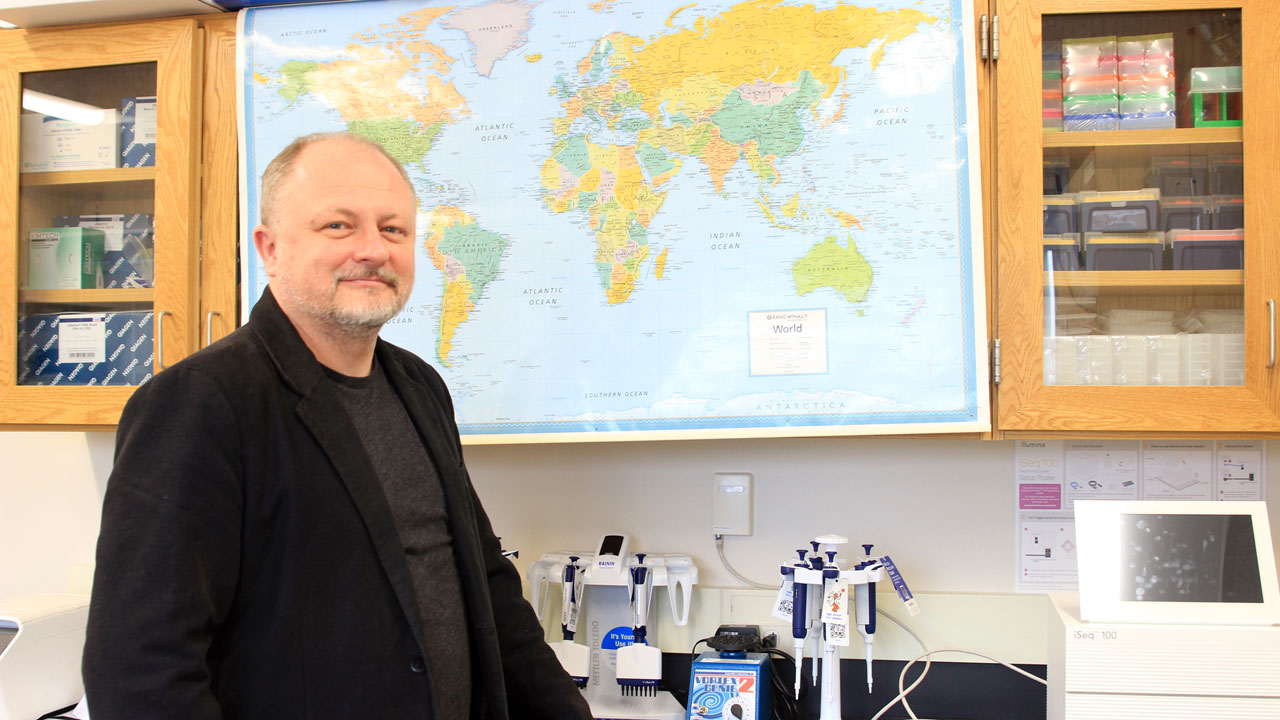- YouTube
- TikTok
Building a world genome map
Biology Professor Taras Oleksyk is at the forefront of an international effort to survey genetic diversity around the globe


For years, scientists around the world have been mapping out billions of DNA bases that make up the human genetic code. Human genomes have been mapped from DNA of populations in the United States, Latin America, Africa, Asia and Western Europe.
In the midst of this progress, however, many places have remained genetically uncharted. This includes Russia, the largest country in the world and the ninth-most populous.
“Russia has been missing from the genomic surveys,” said Taras Oleksyk, assistant professor of biological sciences. “There’s been no light shining on it in terms of genomic research.”
Lighting the way
Oleksyk has been working with researchers around the globe to put Russia on the world genome map.
In 2014, as a visiting scientist at St. Petersburg State University, Oleksyk received a grant from the Russian Academy of Sciences, which he used to initiate the Genome Russia Project, an international effort to map the genome of Russian populations. He was joined in this effort by colleagues Vladimir Brukhin and Stephen J. O’Brien, who organized a conference inviting scientists from research groups throughout Russia to collaborate on the project.
“We need to know what the entire map looks like so we can understand our place on it.”-Taras Oleksyk, assistant professor of biological sciences |
On an even larger scale, the project is part of an ambitious effort to chart genetic diversity worldwide, helping scientists contextualize the evolution of all humanity.
“As people have spread across the world over centuries, they have gained different genetic characteristics, either at random or due to adaptation to their local environments,” said Oleksyk. “These differences are crucial for understanding who people are and where they came from.”
Moreover, mapping the world’s genomes provides insight into the role that genes play in shaping the characteristics of populations. These include not only obvious features – like hair and eye color – but also more subtle attributes that impact survival, such as adaptations (or vulnerabilities) to disease, altitude and climate.
Who are the Russians?
To understand the effects of genetic variations, scientists first need to identify them through the process of genome mapping. Russia is especially important to the world genome map, since it is one of the most ethnically diverse countries, with nearly 200 ethnic groups.
“Russia is a treasure trove of previously undescribed genetic variations,” Oleksyk said. “Mapping them will allow scientists to chart the vast genetic diversity of Russian populations and fill in the largest gap on the genetic map of humankind.”
In a newly published article in the journal Genomics, Oleksyk collaborated with researchers around the world to analyze whole genome sequences of individuals from the Pskov and Novgorod regions of Western Russia, and the Yakutia region of Eastern Siberia. The study examined genetic profiles of 264 adults and identified six geographic partitions to delineate areas of similar genetic variation among native populations in European Russia, Siberia, Central Asia and the Caucasus.
“We established the borders to show areas where people are more genetically similar to each other – sort of like genetic countries,” Oleksyk explained. “This shows that history and geography shape our genomes. Where we are from largely defines the genetic characteristics we carry. And that has important implications, particularly for genes that influence our health.”
The researchers illustrated this point when they examined genetic predisposition to four biomedical conditions among the Russian populations and their neighbors. The conditions were lactose intolerance, Warfarin (blood thinner) response, skin pigmentation and retinitis pigmentosa.
The Pskov and Novgorod of Western Russia were identified as more prone to retinitis pigmentosa, like their Western European neighbors, while the Yakuts of Eastern Siberia were found to be at higher risk for lactose intolerance, like their East Asian neighbors. The Yakuts also showed a much lower response to Warfarin, similar to the East Asians.
“That is what we found across the board,” said Oleksyk. “The Russian genomes are admixed, and therefore, reflect genetic influences from their neighbors.”
Precision medicine and beyond
According to Oleksyk, genomic knowledge related to disease risk and drug efficacy holds particular promise in the field of precision medicine.
“The goal is to give doctors the ability to tailor medical treatments to their patients’ genetic profile,” he said. “For example, making sure that patients don’t have a genetic predisposition that prevents them from metabolizing certain drugs. We need genome maps in order to lay the groundwork for this type of personalized medicine.”
He added that genome mapping also allows people to discover their place in the context of human evolutionary history – which includes everything that has shaped humanity through the ages, from epidemics and famines, to migration and trade, to war and peace.
“All of these factors shape our genomes and make us who we are,” Oleksyk said. “We need to know what the entire map looks like so we can understand our place on it. Every genome is a point on the map and a page in the annals of our natural history.”


 January 13, 2020
January 13, 2020